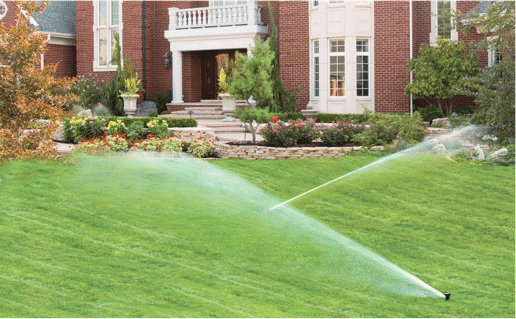We’re currently enjoying some beautiful fall weather in the Midland, Bay City and Saginaw area, and conditions are still perfect for renovating or rejuvenating your lawn. However, before you know it the colder weather will be here, so it’s not too early to be thinking about what steps to take to help your lawn make it through the snow and freezing conditions of winter. Here are a few things to think about, especially if you’re the do-it-yourself type:
Aerate: Aerating can help a lawn recover after a long summer and help it survive the potentially harsh months that lie ahead. Aerating, which involves puncturing the soil or removing cores of soil from the ground, can restore a lawn to health by improving its drainage and allowing more water and air to reach the roots of the grass. Aerating also makes it easier for nutrients to penetrate the soil, which encourages a healthier lawn over the long haul. Parents of small children who spend lots of time in the yard may need to aerate their lawn more than most, as heavy lawn traffic compresses the soil, a potentially harmful process that can be reversed via aeration.
Fertilize to strengthen the roots: Aerating promotes stronger roots, but homeowners should also apply a winterizing fertilizer with potassium and phosphorous, both of which can strengthen roots. Different types of lawns will respond differently to certain winterizers, so discuss your options with a lawn care professional who can help you find the right fit for your property.
Treat trouble spots: Summer can be even harder on a lawn than winter, especially for those lawns located in regions where heat waves and drought are common. In such instances, certain spots on the lawn seem to be hit harder than others, and those spots should get special attention when winterizing the lawn. Check the soil’s pH levels before fertilizing or applying any treatments. Such a test will reveal which spots need the most attention, and treating trouble spots now will make spring lawn care that much easier.
Don‘t procrastinate: Putting off the process of winterizing a lawn can put that lawn in jeopardy. Lawns will turn dormant the closer you get to winter, and they may reject the nutrients found in fertilizer as a result. Those nutrients will prove valuable once spring weather returns, so start the winterization process in early fall so the lawn has sufficient time to absorb nutrients and strengthen itself for the seasons to come.
Remove debris from the lawn: Debris left on a lawn over the winter can prove very harmful. Piles of debris left scattered around a lawn can suffocate the blades of grass, leading to long-term damage and a potentially unsightly lawn come the spring. In addition, piles of debris might make good homes for organisms that can damage the lawn. As fall moves into winter, periodically remove all debris, including leaves and branches fallen from trees.
Make the lawn off-limits once the temperatures dip below freezing: A lawn should be off-limits once the ground freezes. Stepping on grass that has frozen will leave noticeable footprints, and walking on frozen grass can kill the turf. When winter arrives, people should avoid using the lawn as a shortcut into and out of your home and stick to driveways and sidewalks instead.
If you’re not the do-it-yourself type give us a call and let us do the aerating, fertilizing and leaf removal for you. That way your lawn will be ready for winter and a jump-start next spring. And you can enjoy more free time this fall!

